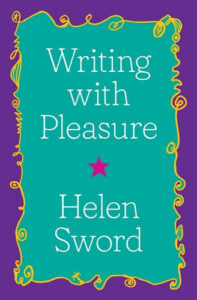The following first appeared in Lit Hub’s The Craft of Writing newsletter—sign up here.
I’ve just returned from a long walk with my dog, Freddie, a cloud-white bichon frisé with a sunny disposition and a jaunty tail. For Freddie, the senses are not a leash but an all-day party: the world of the body is delicious; movement is a joy. For me, a mere human, life is more complicated. Writing hurts my body—which is why I need those long walks even more than Freddie does. My pleasure in intellectual labor is constantly undercut by physical pain: sore back, tight neck, crashing headaches.
But there’s an upside: because I can no longer ignore my body while I’m writing, I have learned to trust its wisdom. Every time I take time out to attend to my body’s needs—pausing to adjust my posture, taking a stretching or breathing break, dancing at my standing desk rather than sitting in a chair for hours on end, pushing myself out the door to take Freddie for another walk—my writing benefits as well.
Writing and thinking are fundamentally physical acts. Yet many writers seem almost embarrassed or surprised to have bodies, like the cerebral Oxford scholars described by Virginia Woolf in a 1907 letter—“you see brains floating about like so many sea anemones, nor have they shape or colour”—or the embrained academics lampooned by educator Sir Kenneth Robinson nearly a century later in a popular TED Talk:
They live up there, and slightly to one side. They’re disembodied, you know, in a kind of literal way. They look upon their body as a form of transport for their heads, don’t they? It’s a way of getting their head to meetings.
The fantasy of disembodied cognition offers its own pleasures, no doubt. Imagine living in a paradise of productivity where one could write merely by thinking, with no need for pens, keyboards, food, showers, or sleep! But here in the real world of material existence, we cannot write, think, or speak without recruiting our fragile human flesh to help us. Even Stephen Hawking, the brilliant theoretical physicist immobilized by motor neuron disease, could communicate only so long as he could move some part of his body (toward the end of his life, a single cheek muscle) to activate special speech-producing software.
Because I can no longer ignore my body while I’m writing, I have learned to trust its wisdom.
Rather than regarding our bodies merely as clunky transportation devices for our brains—or, worse yet, as impediments to clear thinking—what happens when we flip the script and invite our bodies to the party, welcoming them into our writing process as collaborators, teachers, and friends? Physical pleasure can provide a fast track to pleasure in writing, whether while we are writing (through attention to posture, keyboarding, and other writing-related movement), before and after writing (through exercise, stretching, and movement), or through attention to the physicality of language itself.
Lurking in the shadows are some less-than-agreeable aspects of human embodiment: unpleasant smells, motion sickness, claustrophobia. The life of the body is always haunted by the specter of physical discomfort and danger, after all. These images of human frailty remind us to embrace the physical pleasures of writing right now, celebrating the bodies that we have in the spaces where we write.
When the protagonist of Marcel Proust’s novel Remembrance of Things Past dips a piece of scallop-shaped cake into a cup of tea and finds himself flooded with “exquisite pleasure,” he unlocks one of the mysteries of human cognition, the profound link between sensory experience and memory:
I raised to my lips a spoonful of the tea in which I had soaked a morsel of the cake. No sooner had the warm liquid, and the crumbs with it, touched my palate, a shudder ran through my whole body, and I stopped, intent upon the extraordinary changes that were taking place… And suddenly the memory returns. The taste was that of the little crumb of madeleine… my aunt Léonie used to give me, dipping it first in her own cup of real or of lime-flower tea.
Proust’s famous “madeleine moment” demonstrates both the power of sensory experience to stir our own memories and the power of sensory language to stir our readers’ emotions. The pleasure he describes has less to do with the taste of cake dipped in lime-flower tea than with his protagonist’s nostalgia for “le temps perdue,” a time now lost.
In academic writers’ narratives of pleasure, the sights, sounds, smells, tastes, and textures of their writing environments are often intimately entangled with their memories of specific writing processes. Marissa recalls how the blues and greens of her writing space merged with the white of her computer screen as it gradually filled with words:
I’m in my pyjamas still—and I have a cup of warm lemon black tea. I sit at my desk chair—it’s green just as my desk, and I have the blinds cracked open so that I can see natural light and feel the light around my space. The color blue comes to mind, but it is a soft blue. The screen is white and I have filled it with words from a previous day’s work, keeping the spaces close so that when I expand into double-space I can see that I have made progress. (Marissa, academic advising, North Carolina)
Peta-Anne’s memories of composing an academic article are infused with soft music, scented oil, and caffeine-rich snacks:
The process included me sitting on the floor of my office surrounded by articles as I categorised them into themes. I had soft music in the background and peppermint oil in the burner as I worked. When I finished sorting, the writing happened with the same atmosphere plus chocolate coated coffee beans. (Peta-Anne, senior lecturer in nursing, Australia)
For Isadora, a law student in Italy, the colors of sea and sky on a perfect winter day in Venice mingle with her thoughts of past, present, and future:
That day I was surrounded by the sea, the sky was clear blue and I was wearing a t-shirt even though it was January. I put some thoughts on paper, in my special book, and visualised my future. I remember that feeling, it was pure joy, feeling the gratitude for everything that I have got and that is coming to me. (Isidora, law student, Italy)
Sometimes it can be hard to distinguish between sensory and intellectual pleasures, as when the smell and taste of food seep into a film script about food:
One of my most pleasurable moments was my time writing New Zealand’s first Indian feature film, Apron Strings. Obviously not all three years it took to write it, but specific afternoons during which my collaborator Dianne and I would write, talk, eat, cook, argue, discuss everything but the story. In talking about our families, fears, obsessions, racism in NZ, non sequiturs, we actually cracked the story and writing would become easy and fulfilling. Exciting. Because I often cooked—soup and baguettes for a “working lunch”—the smell of food was a big part of this process. We were writing a film in which food played a very important role. Food as a metaphor of exclusion, inclusion, nurture and control. (Shuchi, associate professor in media and communication, New Zealand)
When we take the time to notice the sights, sounds, and smells that infuse our scene of writing, we deepen our own enjoyment of the writing process.
Memories of pleasurable writing may also be linked to less-than-pleasurable sensory experiences:
Writing patient notes is often a feast for the olfactory senses. How much blood did the patient lose, what colours was the stuff they coughed up? Just how bad was the smell from the wound? Maybe this is where I found pleasure in writing, describing accurately patient critical information: “The wound site appears infected, wound secondary to extensive trauma, surrounding tissue red, excoriated and hot, wound bed sloughing, with high malodorous exudate (+++), with widespread black necrobic tissue.” So the next nurse to see the patient can understand the severity of the wound, the smell, the sight, the feel. (Dominic, PhD student in nursing, United Kingdom)
Where Shuchi invokes the delicious smell of soup cooking in a suburban kitchen, Dominic recounts a very different kind of “feast”: the sights and smells of a hospital emergency room. His pleasure in the memory is not physical so much as social (communicating effectively with another highly trained professional), aesthetic (delighting in finding just the right words), and creative (rising to a cognitive challenge).
Attention to sensory experience can thus pack a triple whammy of writing-related pleasure. When we take the time to notice the sights, sounds, and smells that infuse our scene of writing, we deepen our own enjoyment of the writing process. (Yes, that vanilla-scented candle on your writing desk really can boost your mood while you’re writing.) When we write sentences packed with sensory detail, we deepen our own pleasure in the craft. (As soon as that vanilla-scented candle entered this paragraph, I felt a ping of authorial satisfaction.) And when we connect with our readers through vivid sense imagery, we deepen their delight, too. (Even if you hate the smell of vanilla, you can appreciate the care with which I have inserted that candle into this paragraph.)
The personal narratives here entice us with the sound of soft music and animated conversation, the smell of darkroom chemicals and fragrant tea, the sight of sparkling Venetian canals and infected wounds—and the promise of the pleasure that awaits us whenever we open our minds to our bodies.
_________________________________

Excerpted from Writing with Pleasure by Helen Sword. Reprinted with permission from Princeton University Press.
